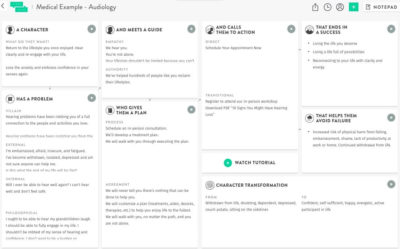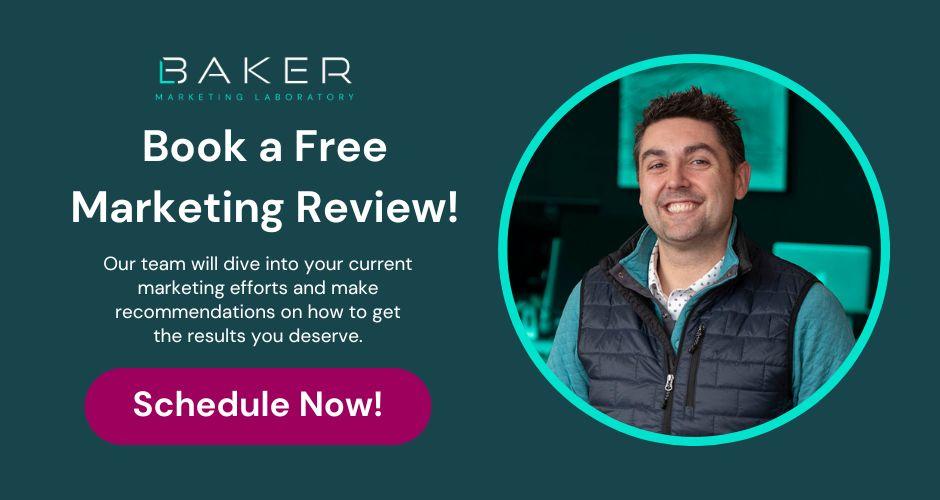Let’s face it. Healthcare communication can be confusing for patients. If a physician or medical practice posts content on a blog or on social media, it’s often either too technical for patients to clearly understand, or sounds too much like a lecture.
However, patients are thirsting for sound medical information, and they’re going online to try to find it. According to research published by Google, 77% of patients turn to search engines to start their health journey. With this in mind, it’s more important than ever to market your healthcare practice in a way that connects with your patients. This is exactly why doctors should use the StoryBrand marketing model to reach the right audiences.

Prospective patients are looking for information at every stage of their patient journey, from gathering information to comparing options to making a decision. When they’re searching for health information online, patients want to hear from doctors and their staff. In fact, in 2022 Healthcare Affairs showed that patients said the most trusted healthcare resources online are those posted by physicians (54%), followed by nurses (48%), and scientists and pharmacists (40%).
So how can doctors or healthcare practitioners provide the online information that patients are searching for in a way that’s educational yet also engaging? Better yet, how can physicians and doctors have website content that rises above the deafening online noise and is actually music to potential patients’ ears, inspiring them to schedule an appointment?
Clarity Is Key, And the StoryBrand Marketing Model Delivers
An easy-to-follow marketing tool called StoryBrand provides a framework for creating compelling content with clarity. The StoryBrand framework process is applicable for any business, including any type of medical and healthcare practice.
The beauty and success of StoryBrand is that it clarifies your message so that prospective patients can actually understand what you have to offer, and why you’re the one to help them. The founding principle of the StoryBrand marketing message is clarity, because as StoryBrand Founder Donald Miller says: “Confuse, and you’ll lose.”

The essence of StoryBrand is that you use storytelling to communicate in a simple yet sophisticated way that patients will actually hear and respond to. True to all good storytelling, StoryBrand relies on a hero and a villain to demonstrate the value of any product or service.
Here’s the StoryBrand framework:
1. A patient/hero
2. Has a problem (internal, external, and philosophical)
3. And meets a guide
4. Who has a plan
5. That calls them to action
6. That helps them avoid failure
8. And ends in success
Who’s The Hero?
Here’s the crux: The patient is the hero, not the doctor or medical practice. As Miller says, “Your brand is not the hero of the story. Your customer is.” When it comes to medical practices, this translates to your doctor or hospital or expertise is not the hero, your patient is.

This may seem counterintuitive because medical practices typically position themselves as the hero in any patient/doctor scenario, and why not? It makes sense to take the stance of “I’m the doctor and I know what to do to solve your health problem and make it all better.” But that doesn’t put the power in the patient’s hands or invite them into your story, and it is, after all, the patient’s journey.
When you make the patient the hero, you place the power in their hands to take action in order to make the transition from feeling ill or having a health problem to feeling more healthy. Whether this is in the form of scheduling a consultation, following a doctor’s medical advice, or agreeing to have a procedure done, being motivated to take action empowers the patient. And when patients feel empowered, they are much more likely to engage with and stay loyal to a doctor or medical practice.
Each patient’s journey involves a problem, which is their medical condition or illness, and a goal, which is resolving the problem and having better health. You need to be clear about what the patient wants. As soon as you define something a potential patient would want in detailed imagery, such as enough energy to play with the grandkids or being able to garden again without back pain, you show that you understand their problem and their goal. This sets you up to be the trusted guide who can lead them on their hero’s journey to better health.
Every Hero Needs A Villain
In the StoryBrand marketing model, the villain is every bit as important as the hero. Just like with any timeless story, the hero can’t actually be a hero without defeating or overcoming a villian. Think Harry Potter and Voldemort, Batman and Joker, Luke Skywalker and Darth Vader.
For patients who are positioned as the hero, the villain would be their health-related problem, or the medical condition they want to manage or overcome. As much as possible, the problem or villain should have personified characteristics. For example, if an illness is causing a man to miss out on golfing with his buddies, it could be personified as a giant, heavy ball-and-chain that’s locked around his ankle.
Personifying the problem, or villain, will help you clearly convey the three levels of any problem that a patient struggles with. It’s not just the pain or illness itself that’s the problem, it’s how it makes the patient feel and how it affects their life.
The three levels of problems the villain creates are:
- External
- Internal
- Philosophical
The external problem is the physical, tangible problem the patient is struggling with. It’s the diagnosis of a disease, or the mysterious symptoms that have not yet been diagnosed, or the pain a patient is tired of having.

The internal problem is how the external problem makes them feel—weak, sick, frustrated, angry, scared, etc. When you can identify those internal problems, name them, and offer to help patients resolve them along with the original external problem, you are again showing patients that you will understand them and can guide them towards a solution. Doctors and medical practices are very good at marketing to these obvious external problems, but the reality is that people buy solutions to internal problems.
The philosophical problem can best be talked about with the terms “ought” and “shouldn’t.” I ought to be able to go golfing with my friends or out to dinner with family without having back spasms. I shouldn’t have to lose sleep and be tired all the time because of restless leg syndrome. The patient wants these problems to go away. They just need a guide to help them figure out how.
And The Guide Is … YOU!
The fatal mistake too many medical practices make is positioning themselves as the hero instead of the guide. But patients aren’t looking for a hero, they’re looking for a guide to show them the way.

If you market with messages about how great your expertise is, or what your success rate is, or how many services you excel at you’ll get lost in the medical marketing noise. You need to turn the focus to the potential patient as a hero on a quest for better health. Then, when you’ve clearly named and described the problem your potential patients are facing through creating a story with a hero and a villain, you position yourself as a compassionate, experienced guide who can lead them to a solution.
There are two things you must communicate in order to position yourself as the guide:
- Empathy
- Authority
Unlike sympathy, which is defined as feeling sorry for someone, empathy is the ability to stand in a patient’s shoes and convey an understanding of the patient’s situation along with the desire to help. When you empathize with patients’ dilemma, you create a bond of trust. And study after study has shown that when doctors express empathy, patients report higher rates of satisfaction and loyalty, with fewer malpractice suits.
Your marketing messages need to demonstrate that you’re empathetic with statements that start with words like, “We understand how it feels to”… or, “You shouldn’t have to experience…”
You then need to establish that you have the authority it takes to guide the patient to health. This is, again, where too many medical practices default to the bragging role and step in as the hero. When looking for a guide, a patient simply wants to know that you know what you’re doing and have helped others in similar situations.
There are four ways to show you’re qualified to guide the patient through their journey:
- Use testimonials from other patients you’ve helped
- Use statistics about how many patients like them you’ve helped
- List any awards or accolades at the bottom of your webpage.
- Display modest-sized logos of any medical organizations or societies you’re associated with.
Mapping The Patient’s Journey—An Example
Positioning the patient as a hero facing a problem, and your practice as the caring, qualified guide who will help them resolve that problem, is the foundation for telling a story that will truly speak to potential patients. From this point, the patient’s journey to your waiting room begins.

Let’s walk through how StoryBrand would market for each stage of the patient’s journey with a fictitious practice as an example. Imagine that you manage an ENT practice which has recently hired an audiologist to expand their services for patients with hearing loss or ringing in the ears from tinnitus.
Patient/Hero
A patient’s hearing may have been slowly eroding, or they may have experienced a sudden onset of ringing in their ears. Either way, patients with hearing loss want to hear clearly again.
Problem/Villain
Hearing loss often leads people to disengage, either willingly or not. You could tell the story of a patient who stopped going out to dinner with her friends because she couldn’t hear the conversation, or the patient who sat in a corner at family gatherings because he was embarrassed that he couldn’t hear. Then, break the problem down into the three levels:
The villain is the external problem which, simply put, is hearing loss.
The internal problem is how the hearing loss makes people feel, such as embarrassed, angry, scared, helpless, frustrated, or anxious.
The philosophical problem is that they “ought” to be able to hear clearly and be fully engaged in conversations. Or, that they “shouldn’t” have to feel anxious because they can’t hear what’s going on around them well enough.
To personify the problem, you could describe how hearing loss is like a thief dressed in black, who is stealing your connection to family and friends, or who is robbing you of your sense of security.
Marketing messages might include:
Have hearing problems been robbing you of a full connection to the people and activities you love?
If hearing problems have been isolating you from the people and activities you love, there’s hope.
We know it’s exhausting to constantly be dealing with hearing loss.
Guide

You position yourself as the guide by showing empathy and establishing your authority in the field. You can demonstrate empathy by expressing that you know the internal and philosophical problems that hearing loss so often creates—isolation, insecurity, frustration, etc.
Marketing messages might include:
We hear you, and we’re here to help.
Your lifestyle shouldn’t be limited because you can’t hear well. We will help you step fully back into your life.
You ought to be able to clearly hear your grandchildren laugh, and we can help.
You also establish your audiology services as an authority in the field by including testimonials, statistics, awards, and logos of related medical affiliations on your website and marketing materials.
The Plan
As the guide, explaining your process plan to patients should be simple and direct so that it steers clear of confusion. Describe the process that a patient would go through from a first phone call to treatment in as few steps as possible. For example:
1. Schedule an in-person consultation online or over the phone.
2. We’ll carefully listen to your concerns and together we’ll develop a treatment plan.
3. Together, we’ll walk through every step of the plan until your issue is resolved.
In addition to the actual process plan, the practice should promote an agreement plan of how they will interact with each patient and what they promise to provide. While the process plan alleviates confusion, the agreement plan alleviates fear.
For example, marketing messages might include:
We promise to listen carefully to your concerns.
We will never tell you there’s nothing that can be done to help you.
We will customize a plan to help you enjoy life to the fullest again.
We agree to walk with you until you’re satisfied that your hearing is as robust as it can be.
Call To Action
Every page of your website should have a prominent call to action that says something like “Request An Appointment.” The call to action should link to a page on your website where patients can enter their contact information so that someone can contact them to schedule an appointment.
Other invitations for potential patients to take action might include registering to attend a workshop with the audiologist, viewing a webinar, or downloading a quiz to assess how much hearing loss is affecting the patient’s life. There are numerous smart marketing tools you can include on your website to encourage patients to engage with your practice and take action, such as:
- Quizzes and assessments
- Webinars
- eBooks
- Infographics
- Case studies
- Videos
Avoiding Failure
Every good story hinges on the question of whether the hero succeeds, or fails. In medical marketing, both sides need to be told. What negative consequences are you helping patients avoid if they seek your help?

In the case of audiology, for example, you need to show what can happen when people with hearing loss fail to take action. This can be done by empathizing with the increased risk of physical harm from not hearing alerts, for example, or by expressing that you know how embarrassing hearing loss can be, or how it easily creates withdrawal and isolation if allowed to progress.
Successful Outcome
Show what happens when people with hearing loss do take action. Tell about how a patient was scared and doubtful when they first came to you, but now they finally have the right diagnosis and hearing aid device so that they feel confident and secure again. Show the transformation from the pain or problem that hearing loss created to the happy, successful outcome you guided them to.
Your patient is now reconnected to loved ones and is living life with clarity and energy again, which truly makes him feel like a hero. And you were the compassionate, experienced guide who led the way.
StoryBrand Framework for Medical & Healthcare Practices
If your website isn’t generating the kind of interest from new patients that you think it should, it’s time to change things up. The StoryBrand marketing model will help you clarify your message in a way that current and potential patients can actually relate to, which will ultimately grow your practice.
Once you go through the StoryBrand framework for your own practice, you can then begin weaving the messages you’ve come up with into your website, blog, social media posts, and more.
Excited to get started transforming your messaging and reach the right patient audiences? To learn more about the StoryBrand framework, read Building a StoryBrand: Clarify Your Message So Customers Will Listen. You can also talk to a marketing agency who understands the nuances of healthcare marketing. That might be us! We have over a decade of experience partnering with healthcare groups across the country and the world with proven strategies to clarify their messaging and reach the right patients. Book a free consultation with us today to discuss your marketing goals and how you can level up your messaging with the StoryBrand framework.

*This blog post was originally published in August 2018. It has since been updated with new and recent information for clarity.


